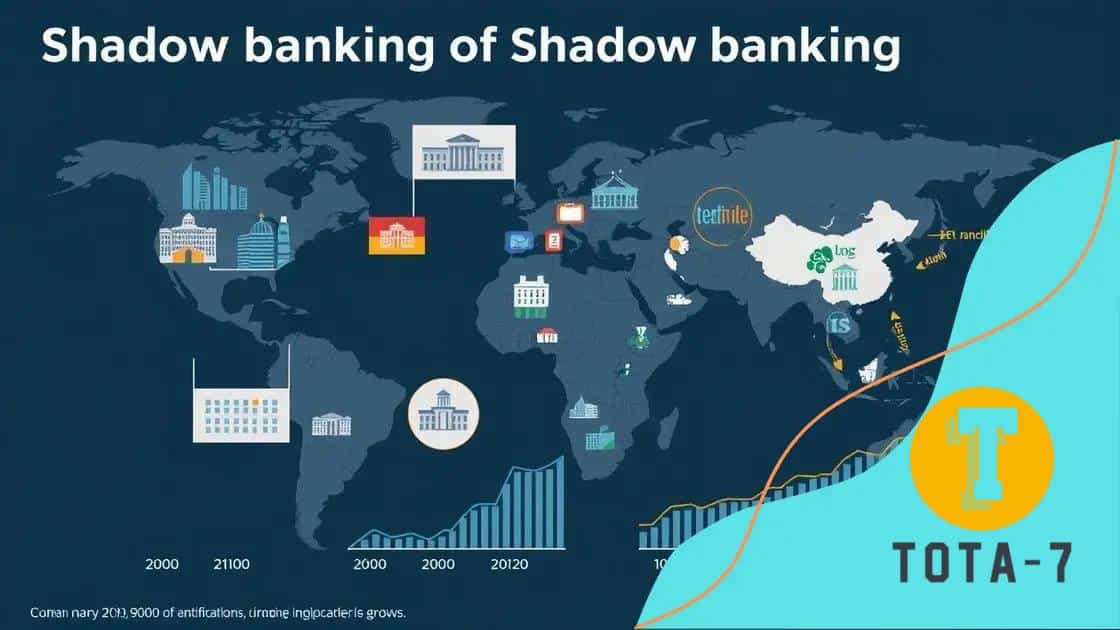Shadow banking growth raises global financial risk

Shadow banking growth raises global financial risk by introducing significant challenges such as lack of transparency, systemic risks, and liquidity issues, prompting regulators to enhance oversight and adapt to the evolving financial landscape.
Shadow banking growth raises global financial risk and invites scrutiny over its impact on stability. What does this mean for the global economy? Let’s explore these critical dynamics and their implications.
Understanding shadow banking and its mechanics
Understanding shadow banking is essential for grasping its role in global finance. This financial sector encompasses various entities and activities outside traditional banking regulations.
Shadow banking refers to non-bank financial intermediaries that provide services similar to those of traditional banks. These include investment funds, insurance companies, and money market funds. They play a significant role in intermediating credit but do not operate under the same regulatory framework.
Key Components of Shadow Banking
Several important entities contribute to the shadow banking system, including:
- Investment funds that manage substantial pools of assets
- Mortgage companies that provide loans without being fully regulated
- Hedge funds engaging in higher-risk lending practices
- Special purpose vehicles that finance various assets
This system allows for flexibility and innovation in the financial services sectors. However, it also introduces certain risks that aren’t always visible to regulators.
Risks Associated with Shadow Banking
While shadow banking can enhance liquidity and credit availability, it may also lead to significant financial risks. Some of these include:
- Increased market volatility due to unregulated activities
- Higher chances of systemic risk from interconnected entities
- Potential for lack of transparency affecting investors
Understanding these risks is crucial as they can have far-reaching implications on the global economy, particularly during financial crises.
Furthermore, because shadow banks operate outside typical regulations, they can contribute to economic instability. It’s essential for stakeholders to be informed about the dynamics of this financial sector.
The growth trends of shadow banking globally

The growth trends of shadow banking globally have raised significant attention among regulators and economists. Understanding these trends is vital to grasp how they affect the overall financial environment.
In recent years, shadow banking has expanded rapidly. Factors contributing to this growth include increased demand for alternative financing sources and the limitations of traditional banks in offering credit. As businesses and individuals seek more options, shadow banks have stepped in to fill this gap.
Key Factors Driving Growth
Some of the main drivers include:
- Regulatory frameworks making traditional banking less flexible
- Innovative financial products attracting investors
- Low-interest rates encouraging higher risk investments
- Globalization linking markets across countries
This phenomenon has led to a surge in asset management by shadow banks, creating significant market shifts. With increased flexibility, these entities can respond more quickly to market demand. However, this rapid growth also raises questions about stability and oversight.
Regional Variations in Growth
The patterns of shadow banking growth vary by region. For instance, in Asia, there has been a notable increase in the use of shadow banking solutions as businesses evolve rapidly. In contrast, Europe has also seen growth but with a focus on stricter regulations to manage risks effectively.
Monitoring these trends is essential as they highlight the evolving landscape of global finance. As countries adapt to these changes, understanding the implications of shadow banking is crucial, especially during times of economic uncertainty.
Investors and policymakers alike must stay alert to the shifting dynamics and ensure that appropriate measures are in place to manage potential risks.
Potential risks associated with shadow banking
Potential risks associated with shadow banking are increasingly drawing attention from financial experts and regulators. While shadow banking plays a crucial role in providing credit, it also comes with significant risks that can impact the financial system.
One major concern is the lack of transparency. Shadow banks often operate outside traditional regulatory frameworks, making it difficult for regulators to assess their overall impact. This opacity can hide systemic risks, meaning that problems might not be visible until they develop into a crisis.
Systemic Risk Factors
Systemic risks in shadow banking include:
- The interconnectedness of financial entities, which can cause a ripple effect
- Possible liquidity issues, where funds may not be easily accessible
- Higher volatility due to unregulated products
- Conflicts of interest and lack of proper governance
Each of these factors can contribute to destabilizing the financial system, especially during economic downturns.
Regulatory Challenges
Regulating shadow banking is challenging due to its diverse nature. Policymakers must find a balance that allows innovation while ensuring stability. Regulators worldwide are exploring different methods to monitor shadow banking activities more closely.
Moreover, the global nature of shadow banking complicates regulation. Efforts in one country can be undermined by activities in another. Therefore, international cooperation is essential in addressing these issues effectively.
Another important aspect is investor protection. Consumers and businesses may not fully understand the risks they face when engaging with shadow banking entities. Educating the public about these risks will be crucial in minimizing potential financial harm.
Regulatory responses to shadow banking expansion

Regulatory responses to shadow banking expansion have become a priority for many governments. As shadow banking grows, addressing its unique challenges is crucial for maintaining financial stability.
Regulators are concerned about the absence of proper oversight in shadow banking. To mitigate risks, they are implementing measures aimed at increasing transparency and accountability. One approach involves enhancing reporting requirements for shadow banks, allowing regulators to better monitor their activities.
Global Regulatory Frameworks
Many countries have started to adopt global standards such as those set by the Financial Stability Board (FSB). These frameworks focus on:
- Identifying and assessing shadow banking entities
- Improving data collection and sharing among regulators
- Ensuring that regulatory measures adapt to emerging risks
- Promoting international cooperation on cross-border issues
Such standardized measures aim to create a more harmonized regulatory environment, reducing systemic risks associated with shadow banking.
National Initiatives
In addition to international standards, numerous countries are crafting tailored regulations. For example, the European Union established the Capital Markets Union to boost transparency in financial transactions. Similarly, the United States has emphasized monitoring financial stability through various agencies.
Moreover, regulators are encouraging partnerships between traditional banks and shadow banks. These collaborations can help establish best practices while ensuring that financial services remain accessible. However, this poses its own challenges, as conflicts of interest may arise when roles blur.
Ongoing dialogues among industry stakeholders are essential. They help regulators understand the implications of potential measures, fostering a proactive approach to ensuring safe and resilient financial systems against shadow banking risks.
Future outlook for shadow banking and financial markets
The future outlook for shadow banking and financial markets is complex, as it intertwines with technological advancements and regulatory environments. With the rapid growth of shadow banking, predicting its trajectory is crucial for investors and regulators alike.
One significant trend is the increasing integration of technology, such as blockchain and fintech solutions. These innovations are changing how transactions are conducted, making them faster and more efficient. As a result, shadow banks can offer new financial products that cater to a broader audience.
Emerging Trends in Shadow Banking
Several trends are emerging in the shadow banking arena:
- The rise of peer-to-peer lending platforms, connecting borrowers directly with investors
- Enhanced data analytics for better risk assessment and decision-making
- Growth in sustainable finance options, appealing to socially conscious investors
- Continued demand for alternative financing amidst traditional bank constraints
These trends suggest that shadow banking could become even more influential in financial markets.
Potential Challenges Ahead
However, challenges remain. With growth comes increased scrutiny from regulators, who aim to ensure that these markets operate safely. Potential regulatory changes could reshape how shadow banks function and their relationship with traditional banks.
Additionally, as financial markets become more interconnected, the risks associated with shadow banking could escalate. Policymakers need to remain vigilant in understanding the evolving landscape to mitigate potential risks while allowing innovation to flourish.
Investors must stay informed about shifts in the regulatory landscape and adapt their strategies accordingly. As shadow banking evolves, those who understand these changes will be better positioned to navigate the future of financial markets.
FAQ – Frequently Asked Questions about Shadow Banking and Financial Markets
What is shadow banking?
Shadow banking refers to non-bank financial intermediaries that offer services similar to traditional banks but operate outside regulatory oversight.
What are the main risks associated with shadow banking?
The main risks include lack of transparency, systemic risk due to interconnectedness, and potential liquidity issues.
How are regulators responding to shadow banking growth?
Regulators are increasing oversight, enhancing reporting requirements, and fostering international cooperation to manage risks.
What trends are shaping the future of shadow banking?
Emerging trends include advancements in fintech, peer-to-peer lending, and a focus on sustainable finance options.





